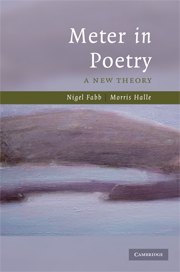11 - The metrical poetry of the Old Testament
Published online by Cambridge University Press: 06 July 2010
Summary
Introduction
A major portion of the Old Testament (OT) is poetry, and, like all poetry (see Chapter 1), is composed of lines. Most OT poetry is not metrical in that the lines that make up this poetry are not subject to restrictions on length. The topic of this chapter is the small minority of OT poetry that is made up of lines that are subject to restrictions on length, and is therefore metrical. Unlike the other kinds of metrical poetry discussed in this book, the metrical poetry of the OT depends solely on the raw number of syllables that make up its lines. It is unique among the meters in this book in that it has no recourse to the metrical grid and to grouping of syllables inside the line.
The standard text of the OT was established by a group of Jewish scholars, called the Masoretes, at some time between 600 and 800 CE, i.e., a thousand or more years after most of the original writings were composed, and it is well known that the text as it has come down to us fails in various ways to reproduce the original wording. This is shown most clearly with respect to the passages that appear more than once in the Old Testament. For example, Psalms 14 and 53 reproduce the same underlying text, but when compared in detail significant differences between the two versions are readily noted.
- Type
- Chapter
- Information
- Meter in PoetryA New Theory, pp. 268 - 284Publisher: Cambridge University PressPrint publication year: 2008



